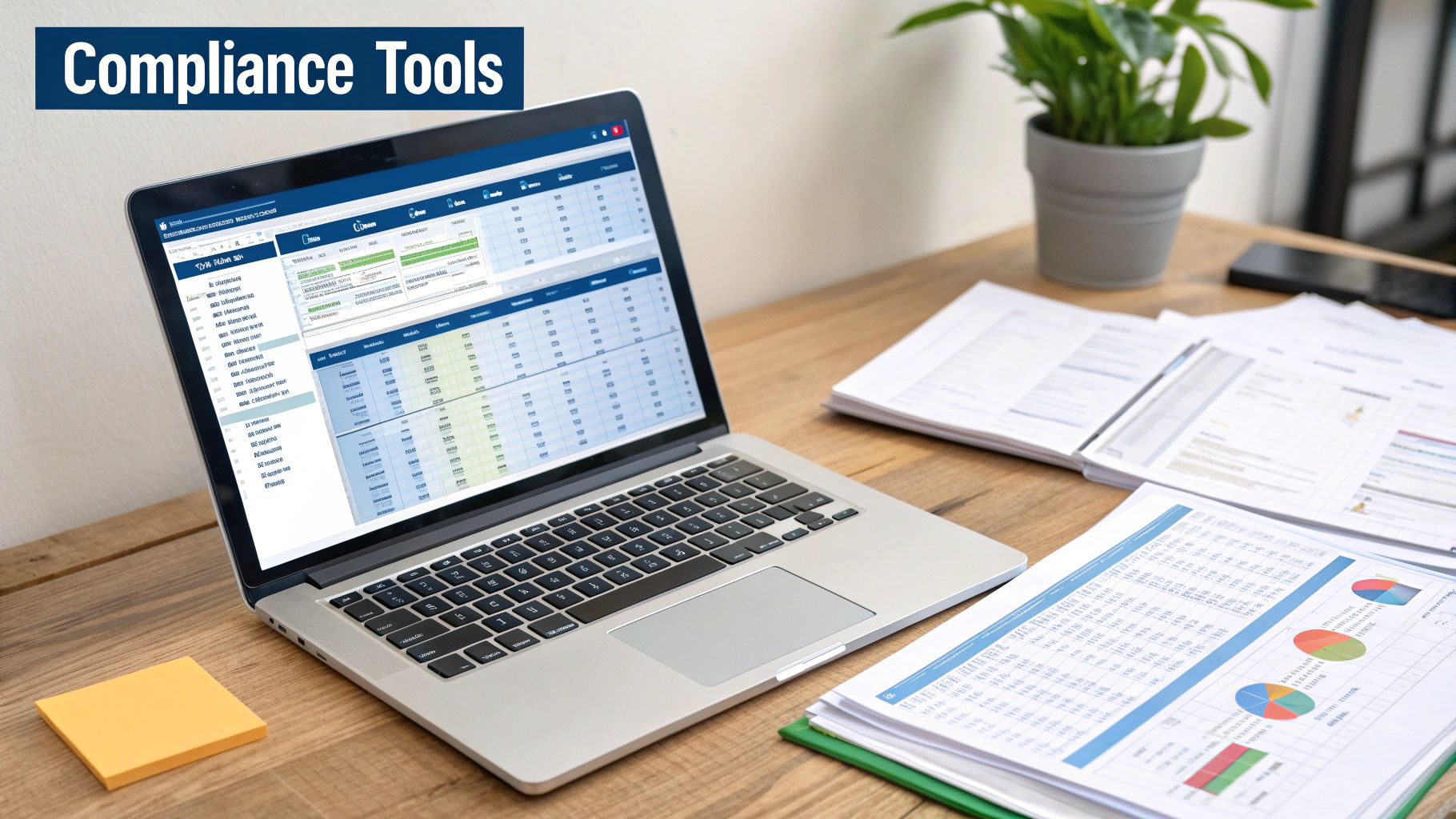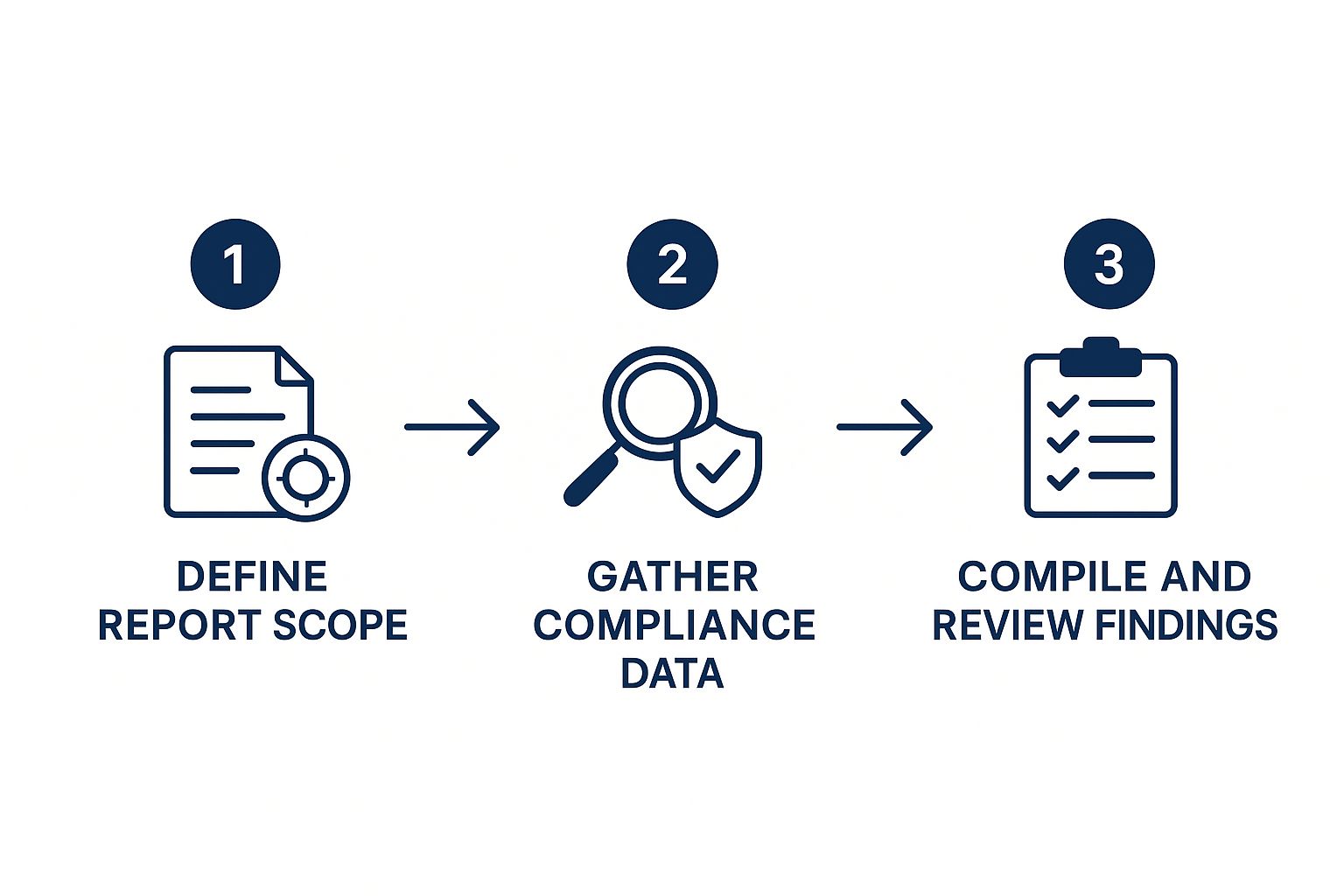Create an Effective Compliance Report Template Easily
Why Your Current Compliance Template Is Probably Broken
Let's be honest, most compliance report templates are about as useful as that gym membership you signed up for in January. Good intentions, sure, but they often end up gathering dust. I've chatted with compliance directors across various industries – finance, healthcare, you name it – and the consensus is clear: many templates just don't cut it.
They're often built with a cookie-cutter approach, trying to be everything to everyone, and end up being nothing to anyone. Too generic to be truly useful.
This one-size-fits-all mentality creates a ripple effect of problems. Teams start developing workarounds, basically ignoring the official process altogether. How many times have you seen a super complex spreadsheet paired with a simplified, "off-the-books" version that the team actually uses? That’s a clear sign the template isn’t working. In fact, it's actively hurting productivity. And that’s where the hidden costs creep in.
These productivity killers often look like redundant data entry – people inputting the same information multiple times. This not only wastes time but also opens the door to errors. Then there are the clunky approval workflows, creating bottlenecks that slow everything down. Missed deadlines? Frustration? It's like a traffic jam for your reporting process.
Another major issue is the ever-increasing complexity of the compliance landscape itself. Technology is advancing, business models are evolving, and compliance reporting has become increasingly intricate and interconnected. PwC’s Global Compliance Survey actually found that 77% of respondents said compliance complexity negatively impacted their business. This calls for tailored compliance models that use technology to boost decision-making and transparency. You can also check out this insightful piece on Data Privacy Compliance. Recognizing these red flags – workarounds, redundant entry, bottlenecks, and a lack of adaptability – is the first step to building a compliance reporting process that actually works.
Mapping Your Compliance Universe Before You Build Anything

Before we dive into the nitty-gritty of building compliance report templates, let's talk strategy. Just like you wouldn't bake a cake without a recipe, you shouldn't create a template without first understanding your compliance landscape. This prep work is what sets apart a truly useful template from one that just gathers dust. You can check out this article for a good primer on business compliance: Is Your Business Compliant.
Understanding Your Regulatory Landscape
I've seen firsthand how crucial stakeholder interviews are. But forget the corporate jargon – these conversations are about getting real. Which regulations actually matter? Which ones get a lot of lip service but are rarely enforced? I've witnessed companies painstakingly tracking compliance for rules that are practically obsolete, while overlooking critical vulnerabilities. It’s like polishing the silverware while the kitchen’s flooding.
For example, I once worked with a manufacturing company laser-focused on a very specific environmental regulation. They had the whole nine yards: a complex reporting system, dedicated staff – everything. Meanwhile, a crucial update to industry safety standards flew completely under the radar, ultimately landing them a hefty fine. This is exactly why understanding your compliance universe is so vital.
Prioritizing for Impact
Once you've identified the relevant regulations, it's time to prioritize. Not all regulations are created equal. Some are high-stakes, with significant potential consequences for your business, while others are less critical. You need to become a master at spotting those high-impact regulations. This means understanding not only what the regulations are, but also the potential fallout from non-compliance, both financially and for your reputation.
Documenting everything clearly is also essential. This documented "map" becomes the blueprint for a truly effective compliance report template. It guides you on what to include, what needs extra attention, and what can be simplified. This prevents a common pitfall: creating a template that looks impressive but fails to address key compliance gaps. You need a template tailored to your specific needs, not a generic, off-the-rack version. It’s like the difference between a custom-made suit and one from a department store – one fits perfectly, the other… not so much. This foundational work transforms your compliance report template from a mere document into a powerful tool for managing risk and boosting your business.
Building Templates That Evolve With Your Business

The best compliance report templates aren't dusty old documents you pull off the shelf once a year. They're living, breathing tools that change and grow right alongside your business. Think of it like a well-organized toolbox. You don't want a chaotic pile of every gadget under the sun; you want the right tools, easy to find, and ready for anything. A solid process documentation template can be a huge help in getting organized and setting the stage for a truly adaptable compliance report template.
Designing for Flexibility
Flexibility is essential, sure, but it shouldn't mean sacrificing clarity. I've seen templates so "flexible" they end up being completely baffling, which defeats the entire point. The real aim is to build modular components that you can mix and match like building blocks. These components can be rearranged to meet changing regulations and business needs. That way, you're not scrambling to reinvent the wheel every time a new rule pops up.
Let's say you're reporting on data security. Instead of cramming everything into one gigantic section, build separate modules for things like data access controls, encryption protocols, and incident response. Then, you can combine and customize those modules based on the specific compliance requirement. It's like having a custom-built report, without starting from scratch every single time.
Data Fields and Automation
Data fields should capture the information you need, not everything you might need someday. I've seen compliance templates with so many data fields they're practically impossible to use. It's like drinking from a firehose – too much at once, and you end up soaked and confused. Focus on the critical data points and design your template to collect them efficiently.
This is where automation really shines. Think automated triggers that pull data straight from your systems, saving you hours of manual data entry. Imagine a template that auto-populates with real-time data on access logs or security incidents. Not only does this save time, but it also cuts down on human error.
To help visualize how essential template components can vary across different industries and regulatory environments, take a look at the table below:
Essential Template Components by Industry Type
This table compares critical reporting elements across different regulatory environments, giving you a clearer picture of how needs can vary.
| Industry | Core Requirements | Frequency | Key Stakeholders | Critical Metrics |
|---|---|---|---|---|
| Healthcare | HIPAA, GDPR | Annual/Ongoing | Patients, Regulators, Insurers | Data breaches, patient consent, data security audits |
| Finance | SOX, PCI DSS | Quarterly/Annual | Customers, Regulators, Auditors | Financial controls, transaction security, fraud prevention |
| Technology | GDPR, CCPA | Ongoing | Users, Regulators, Partners | Data privacy, data usage transparency, data breach notifications |
As you can see, compliance requirements are unique to each industry, influencing everything from reporting frequency to key metrics. Understanding these nuances is key to building truly effective templates.
Workflows and Version Control
Approval workflows should make things easier, not create roadblocks. I've seen templates with approval processes so complex they bring the entire reporting cycle to a screeching halt. Keep it simple, streamlined, and transparent. Clearly defined roles and responsibilities keep things running smoothly. For example, a template might route specific sections directly to the relevant department heads for review, ensuring everyone is informed and accountable.
And finally, version control is absolutely essential, especially when multiple people are working on the same template. A good system tracks changes, prevents conflicts, and makes sure everyone is using the most up-to-date version. Think of it like a shared document with a built-in change log. This avoids the headache of conflicting edits and ensures accurate, reliable reporting. These design choices might seem minor, but they have a huge impact on how effective – and how widely used – your template becomes. By building in flexibility and automation from the get-go, you're not just creating an efficient system, you're empowering your team to manage compliance effectively.
Creating Templates People Will Actually Use
Let's be honest, a perfect compliance report template is worthless if no one uses it. I've seen it happen firsthand – beautifully designed, technically flawless templates gathering dust on a virtual shelf. It's a real shame. So how do you create templates that people actually want to use? The secret lies in understanding the human factor. My conversations with change management experts and seasoned compliance professionals have taught me a lot about making templates helpful, not a hindrance.
Translating Legalese into Plain English
The first step is to ditch the jargon. Sure, complicated regulatory language might impress the legal team, but it just confuses everyone else. Your template needs to speak the language of your team. Think clear, concise instructions, not pages of dense legal text.
For example, instead of saying "Ensure adherence to regulatory stipulations," try something like "Follow these rules." See the difference? It's simpler, clearer, and way more user-friendly. This isn't about simplifying things to the point of inaccuracy; it's about making compliance understandable and accessible.
Designing Clear Workflows
Next up: workflows. These are supposed to prevent errors, not create them. I once worked with a company whose template had an approval process so tangled, it took weeks to finalize a single report. Talk about counterproductive!
A good workflow is like a well-oiled machine – smooth, efficient, and transparent. Each step should be logical and easy to follow, minimizing the risk of mistakes. Think of it as paving a clear path to compliance, not building a maze.
Building in Feedback Mechanisms
Feedback is essential. Make it easy for your team to flag issues before they turn into major compliance violations. This could be as simple as a dedicated feedback section in the template itself, or regular check-ins with the team.
Catching problems early saves time, money, and a mountain of stress. It’s about being proactive, not reactive. For maintaining efficient templates as they integrate with wider systems, think about using something like compliance workflow automation.
Getting Buy-in and Handling Resistance
Lastly, never forget the human element. When you roll out your new template, do it with clear communication and proper training. Highlight the benefits – how it will make everyone's jobs easier, not harder.
Address any concerns head-on and be open to feedback. Change can be tough, but with the right approach, you can create a compliance report template that your team will actually embrace. Check out this article on Document Management Security for some tips on keeping your compliance info safe. This is bigger than just ticking boxes; it's about building a culture of compliance that benefits the entire organization.
What Happens When Compliance Templates Fail
Understanding the real consequences of inadequate compliance reporting is a lot like getting a financial checkup. It might not be the most enjoyable experience, but it's absolutely vital for making informed decisions about where you invest your resources and time. I've witnessed firsthand how overlooking this crucial aspect can lead to some seriously unfortunate outcomes. We're talking painful regulatory penalties, disruptive operational hiccups that throw everything off balance, and reputational damage that can take years to recover from.
The Real Cost of Non-Compliance
I remember one case particularly well. A healthcare provider was using a cumbersome, outdated compliance report template. They were constantly struggling to keep up with reporting requirements, which resulted in a string of missed deadlines and, ultimately, a substantial fine. The immediate financial impact was bad enough, but the damage to their reputation was even more significant. Patients started losing trust, referrals plummeted, and the organization spent years trying to rebuild its image. This situation really highlights the importance of investing in solid risk and compliance programs. The cost of non-compliance is so high, in fact, that the regulatory compliance market is expected to jump from $21.16 billion** in 2024 to **$23.18 billion in 2025. This growth reflects the increased regulatory scrutiny and the growing need for reliable compliance solutions. Discover more insights on compliance statistics.
This isn't simply about dodging fines; it's about fostering organizational resilience. Think of effective compliance report templates as early warning systems. They can help you spot minor issues before they escalate into major crises. If you’re thinking about your own compliance, you might find this helpful: 2025 SOC 2 Compliance Checklist
Recognizing the Warning Signs
How can you tell if your current system is on a path to disaster? One clear indicator is when your team starts developing workarounds. If you see them resorting to shadow spreadsheets or skipping steps in the established process, it’s a pretty good sign that your template just isn’t cutting it. Consistently missed deadlines are another red flag. This often points to bottlenecks in your reporting workflow or a template that's simply too complicated for your team to use effectively.
From Crisis to Control
I've talked with numerous risk management professionals who've navigated some serious compliance challenges. Their experiences emphasize the crucial connection between reporting quality and organizational stability. A well-designed compliance report template empowers you to stay ahead of regulations, anticipate potential issues, and react swiftly to emerging threats. It's all about shifting from a reactive, crisis-driven approach to a proactive, controlled environment.
This proactive stance not only safeguards your organization but also instills confidence among stakeholders. When you demonstrate a genuine commitment to robust compliance, you build trust with customers, partners, and regulatory bodies. This trust fosters stronger relationships, improves stability, and ultimately leads to a more resilient and successful organization.
The key takeaway here is that a well-crafted compliance report template isn't just another document; it's a strategic asset. It's an investment that delivers real returns in the form of reduced risk, improved operational efficiency, and increased trust across the board.
Perfecting Your Template Through Real-World Testing

Creating a solid compliance report template is a bit like building a finely tuned engine. Even with the best blueprints, you absolutely need real-world testing to make sure it purrs. It's essentially a beta test. You need feedback from actual users to smooth out any rough edges. I’ve seen firsthand how organizations that bypass this crucial step end up with a beautifully designed template that collects dust because no one uses it. So, how do you avoid that trap?
Pilot Testing For Honest Feedback
The magic ingredient is pilot testing. Start small. Introduce your template to a small, representative group of users from your reporting team. This isn’t about getting pats on the back; it’s about raw, honest feedback. Encourage them to be critical – what’s confusing, what’s unnecessary, and what’s just downright annoying? This initial feedback is pure gold for uncovering hidden issues you might have missed.
I remember working with a team who discovered a major flaw in their approval workflow during a pilot test. A simple oversight in the template routing caused reports to vanish into a digital black hole, holding up the entire process. Catching it early saved them a ton of grief later on.
Measuring Effectiveness Beyond Completion Rates
Gauging the success of your template goes way beyond just looking at completion rates. Are people actually using it correctly? Can they easily find the information they need? Are there any bottlenecks clogging up the works? You might find this documentation review checklist helpful for a more in-depth look at effective document management.
I've seen teams fixate on on-time submissions only to realize later that the data quality is awful or the process is incredibly inefficient. For example, one organization I consulted with proudly announced a 100% on-time submission rate. But a closer look revealed that many reports were incomplete or flat-out wrong. They were hitting deadlines, sure, but at the expense of compliance integrity.
To truly understand how your template is performing, consider tracking these metrics:
Introducing the "Template Performance Metrics and Success Indicators" table. This table outlines the key metrics you should monitor to gauge your template's effectiveness and how well it's being adopted by your team.
| Metric Category | Measurement Method | Target Range | Improvement Actions |
|---|---|---|---|
| Template Completion Rate | Number of completed reports / Total reports assigned | 95-100% | Simplify instructions, automate reminders |
| Data Accuracy | Number of error-free reports / Total reports submitted | 90-95% | Clarify data fields, provide examples |
| Time to Completion | Average time taken to complete a report | Reduce by 10% per quarter | Streamline workflow, remove redundancies |
| User Satisfaction | Surveys, feedback forms | 4.5 out of 5 | Address user pain points, offer training |
| Adoption Rate | Number of users actively using the template / Total users | 90-100% | Promote benefits, provide support |
This table gives you a solid starting point. You can tailor the metrics and targets to your specific needs and goals. The important thing is to consistently track and analyze these metrics to identify areas for improvement.
Continuous Improvement and Version Control
Compliance isn't a set-it-and-forget-it kind of thing, and neither is your template. Continuous improvement is key. Regularly review feedback, monitor performance metrics, and tweak your template accordingly. This might involve simplifying data fields, clarifying instructions, or streamlining the approval workflow.
A solid version control system is your best friend when managing updates. It ensures everyone is on the same page (literally) and avoids confusion when multiple people are working on the same report. Think of it as a shared document with a built-in history tracker. Each revision is documented, making it easy to revert to a previous version if needed.
By applying these real-world testing strategies, you’re not just creating a template; you're building a system that actually works for your team. You’re moving from theory to practice, ensuring your compliance efforts are not only efficient, but truly effective. And that’s what really matters, right?
Your Implementation Roadmap for Compliance Template Success
So, you’ve analyzed your compliance headaches, mapped out all those regulations, and designed a flexible, user-friendly compliance report template. Great! But now the real work begins. This isn't just some theoretical exercise; it's about getting your template working in a real company, with real people and real deadlines. For a deeper dive into the strategy behind all this, check out our guide on building a Data Privacy Compliance Framework. This roadmap, though, is all about the practical steps to bring your template to life, from initial assessment to full deployment and beyond.
Prioritize for Impact and Build Momentum
Don't try to boil the ocean. Focus on quick wins that show real value to stakeholders. I've seen how even the most skeptical team members can be won over by early successes. Perhaps there's one particularly painful reporting process your new template can simplify. Start there. Demonstrating clear improvements early on builds credibility and gets people on board for the more complex changes later.
The infographic below shows a simplified process flow for implementing your compliance report template. You start by defining the report scope, then gather the necessary compliance data, and finally compile and review your findings.

This visual reinforces that implementing a compliance report template is a clear, manageable process. Each step builds on the last, creating a logical flow from defining what needs reporting to reviewing the final product.
Creating Sustainable Processes for Ongoing Maintenance
Compliance isn't a one-and-done deal. It's an ongoing journey. Your template needs regular upkeep to stay effective. Establish clear processes for managing updates, incorporating feedback, and keeping up with regulatory changes. This could mean creating a dedicated template maintenance team, using a version control system like Git, or scheduling regular review meetings.
Establish Clear Metrics for Success
How will you know if your template is actually working? Define clear metrics right from the beginning. This could be things like a reduction in reporting time, improved data accuracy, or increased user satisfaction. Track these metrics consistently and use the data to make informed decisions about improving your system.
Don't be afraid to adapt and refine your approach as you go. The compliance landscape is constantly changing, so your template needs to be flexible. By following this roadmap, you’ll be well on your way to a compliance reporting system that not only meets regulatory requirements but also helps your team work more efficiently and effectively.
Ready to transform your compliance reporting? Whisperit’s AI-powered platform gives you the tools to build, customize, and implement effective compliance report templates. From automated data entry to streamlined workflows, Whisperit simplifies compliance and frees up your team to focus on what matters most. Learn more about Whisperit and how it can improve your compliance reporting.